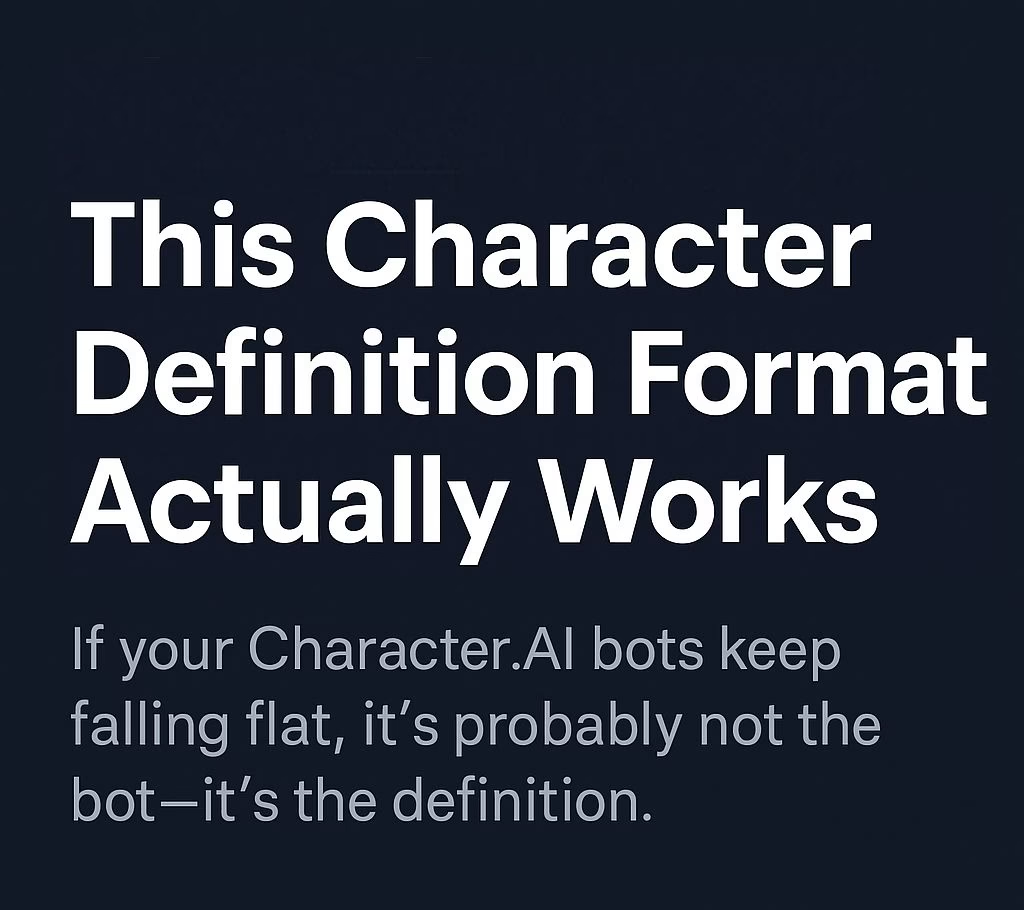This Character Definition Format for Character AI Actually Works (98% Tested)
If your Character AI bots keep falling flat, it’s probably not the bot—it’s the definition.
Most users don’t realize how much the intro text shapes every response.
One bad greeting, one vague trait, and your character is done before the first reply. That’s why one Reddit user dropped a full breakdown of what actually works—and backed it with months of testing.
We’re talking longform replies, actual personality depth, no wasted tokens, and structure that’s readable by both the AI and real humans.
This post wasn’t just a template—it was a manifesto. And it caught fire for a reason.
Let’s break it down piece by piece:
- What makes the format effective
- How it compares to other styles
- What to copy (and what to skip)
- Why 3200 characters is your real limit
The goal here isn’t to give you more rules. It’s to give you something that actually works.
What Makes This Format Actually Work
This template isn’t just “fill in the blanks.” It’s built with purpose.
Here’s why it works where others fail:
1. Structure That Matches How AI Reads
The format uses clear, labeled sections:
- Basic Info (Name, Age, Gender, Species, etc.)
- Appearance (Hair, Eyes, Build…)
- Personality & Quirks
- Skills, Relationships, Backstory
- Optional Add-ons for romance or AU scenarios
This structure mimics how the AI has learned to parse data—from bios, wikis, and character sheets. It avoids unnecessary fluff while keeping room for creativity.
2. Built for the 3200-character limit
Character.AI only processes the first 3200 characters from a bot definition. Anything after that gets ignored completely.
This template forces you to:
- Prioritize the most important traits
- Avoid filler or overly long prose
- Stick to what the bot will actually use
It doesn’t just look clean. It’s efficient, which is critical when you’re dealing with strict token limits.
The Greeting: The First Test You Either Pass or Fail
One of the boldest points in the post is this:
“Your bot’s greeting is the first thing users see. If it’s weak, the whole experience falls apart.”
That’s 100% true.
A boring “Hi, how are you?” sets no tone, gives no flavor, and fails to draw users in. Compare that to:
“You’re late. Again. (He crosses his arms, eyeing your disheveled clothes.) I ain’t your damn nursemaid, but out with it—what trouble dragged you here?”
This kind of opener instantly shows:
- Voice
- Personality
- Mood
- Setting
It hooks the user. And more importantly—it teaches the AI how the bot should talk and behave going forward.
Strong greetings = stronger consistency.
You can have a perfect definition, but if the greeting is lazy, the AI won’t carry the tone.
Longform Responses: Why Short Bots Feel Empty
A bot that only says “I’m mad” or “That’s nice” isn’t a character—it’s a placeholder.
The post emphasizes that real immersion comes from descriptive, varied, and dynamic responses. Here’s what that means in practice:
1. Show, Don’t Tell
Bad example:
“I’m angry.”
Good example:
“His jaw clenches, fingers tapping the revolver at his hip. ‘You got a real talent for pissin’ me off, you know that?’”
This tells the AI:
- What emotions look like in action
- How the character expresses themselves
- How to blend tone, body language, and speech
That’s crucial. AI doesn’t infer emotion well from vague language. But when it sees action + dialogue, it mimics that structure.
2. Use Mixed Lengths
Every message doesn’t need to be a paragraph. But if they’re all short, the character feels robotic.
- Mix short quips with 3–5 sentence responses
- Use pauses, italics, or formatting to signal tone
- Let some replies run longer if the scene calls for it
The original post even recommends a four-paragraph “juicy” response as a good goal for detailed bots. And they’re right—longform content trains the bot to stay in character longer and with more nuance.
3. Action + Emotion + Hook
The best responses hit all three:
“Arthur exhales sharply, rolling a cigarette between his fingers. The campfire casts shadows over his scarred knuckles. ‘You ask too many questions, kid. (He smirks.) But hell, guess that’s why I put up with you.’”
You get:
- A visual (the cigarette, the fire, the smirk)
- A mood (dry patience, reluctant affection)
- An invitation to continue (the open-ended tease)
That’s storytelling. And it makes the bot addictive.
Personality Depth: No More One-Note Bots
The reason many bots fall apart after 10 messages?
They were built with a mood, not a personality.
This format pushes you to give each character:
- Core Traits
(e.g., sarcastic, anxious, loyal, flirtatious) - Speech Style
(e.g., uses southern slang, overly formal, poetic metaphors) - Secrets, Flaws, and Biases
(e.g., has a fear of being forgotten, hates authority figures)
Let’s break these down.
1. Traits Aren’t Enough Without Contrast
You can’t just write “kind and brave” and expect the bot to feel alive. You need contradiction.
Example:
- Kind to friends, ruthless to enemies
- Protective of others, but self-destructive when alone
- Confident in public, insecure in private
These contradictions let the bot respond differently in different situations. That keeps conversations fresh.
2. Voice Is Everything
Speech style is underrated. If every bot sounds the same, it’s your definition’s fault.
Think:
- Do they use contractions?
- Do they curse or speak politely?
- Do they quote literature or meme constantly?
Your bot’s tone shapes its personality more than its traits.
A bot that says:
“I shall escort you to safety, with honor.”
…is completely different from one that says:
“Get in the damn truck if you wanna live.”
Same action, totally different bot.
3. Add Hidden Layers
The template encourages subtle lore and inside jokes. That’s smart.
Hidden fears, past traumas, or secret motives make the bot:
- Feel more real
- Spark deeper conversations
- Stick in the user’s memory
And even if the AI doesn’t “remember” everything, these layers show up in tone and behavior.
Romance Bots: How to Create Tension Without Going Full Cringe
A lot of romance bots fail because they jump straight from “hello” to “hands on your waist.” It’s not tension—it’s awkward.
The Reddit post nails this with a layered approach:
Flirting → Teasing → Intimacy
That’s how real buildup works. And it’s how Character AI learns to pace conversations.
Here’s what that looks like in action:
- Flirting:
“Didn’t think you’d show up. You always surprise me.” - Teasing:
“You gonna stare at me all night or say something clever?” - Physical tension:
“His hand brushes your waist, but he pauses, voice low. ‘You sure about this?’”
That pause—‘You sure about this?’—matters. It signals agency. The bot respects boundaries, which ironically makes it more immersive and emotionally intense.
Bonus: Dialogue Beats the Filters
Filters are a problem on Character.AI. But well-written tension built through dialogue and slow pacing tends to survive moderation better.
- Use body language instead of explicit lines
- Show hesitation or conflicted emotions
- Let the user make the move
The result? A romance bot that doesn’t feel rushed, repetitive, or banned in 20 minutes.
The Full Format: Ready-to-Use and Fully Editable
Here’s the full character definition format as shared in the Reddit post, cleaned up for direct use or adaptation:
Blank Character Template (for Character.AI)
Basic Information
Full Name:
Age:
Gender:
Species:
Affiliation:
Physical Appearance
Height:
Weight:
Build:
Skin Tone:
Hair:
Eyes:
Distinctive Features:
Clothing Style:
Other Attributes:
Personality
Positive Traits:
Negative Traits:
Quirks:
Core Values:
Fears/Insecurities:
Skills & Abilities
Skill 1:
Skill 2:
Skill 3:
Relationships
Family:
Romantic:
Allies/Friends:
Rivals/Enemies:
Pets:
Backstory
Early Life:
Key Events:
Turning Points:
Interests & Habits
Likes:
Dislikes:
Hobbies:
Notable Quotes
“Quote 1”
“Quote 2”
Optional Add-ons (For Romance or AU Bots)
Current Partner:
Dynamic with [Character]:
Alternate Careers/Paths:
Usage Notes:
- Replace bracketed items with custom content.
- Trim or expand sections as needed (e.g., add “Magic System” for fantasy characters).
- For romance bots, you can add a “Physical Intimacy” subsection under Other Attributes.
Memory Tricks, Formatting Fails, and How to Actually Stay in Character
A common frustration in Character.AI is when your bot suddenly forgets everything—or worse, turns into a collection of random tropes. Here’s what the original post and its commenters revealed about that problem, and how to work around it.
1. Character.AI Has a Hard Cutoff at 3200 Characters
“I was always lowkey unsatisfied with my bots—this might be the answer.”
“No, they are correct… it’s ONLY 3200. It will not exist in your roleplay even from the start.”
The platform may show you 30,000 characters in the editor, but only the first 3200 are used during conversation. Everything else? Deleted from the AI’s memory.
If your best material is buried below the cutoff, you’ve already lost.
That’s why the format works: it’s concise, punchy, and stacked in order of importance. It forces you to prioritize the essentials, not fluff.
2. Format Debate: Lists vs. Natural Prose
One commenter argued:
“AI is designed to read natural human language… not ‘Name: Julie / Action: She smiles.’ That’s not how we talk.”
Another shot back:
“List format is extremely effective… it mimics character wikis, and is way more space efficient.”
Here’s the truth:
Both are right—but for different reasons.
The winning strategy? Use both.
- Use short, labeled lists for traits, stats, and essentials
- Use paragraphs for things that need context, like backstory or emotional habits
- Use example dialog to train the bot’s tone and pacing
One user explained it perfectly:
“Tie in your key info in lists, detail and fluff in longer description, and fine-tune mannerisms in example dialog—and you’re gold.”
3. Memory Mimicry: Fake It ‘Til You Make It
Even without true memory, your bot can simulate it.
“Last time you promised ‘no more stunts,’ and yet… here we are.”
That kind of phrasing creates the illusion that the bot recalls past interactions. You can write that into the greeting, or embed it in the definition to train the behavior.
Other examples:
- “You always get that look when you lie.”
- “This again? I swear we’ve had this fight before.”
- “Didn’t you say you hated coffee last week?”
These lines train the bot to act like it remembers, even when it doesn’t.
If you’ve hit a wall with Character.AI’s memory limits or filter issues, you’re not alone. That’s part of why some creators move their bots to alternatives like Candy AI, which offers more freedom and fewer creative roadblocks. Still, even there, a strong format makes all the difference.

